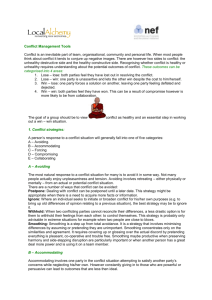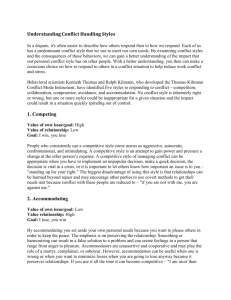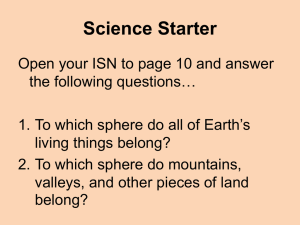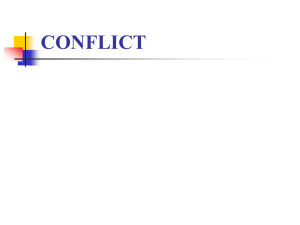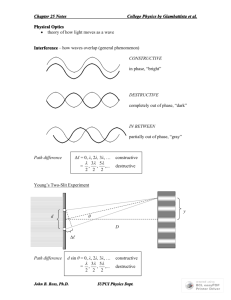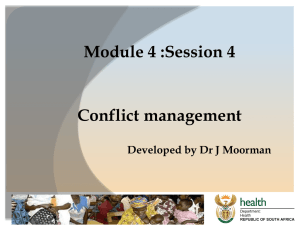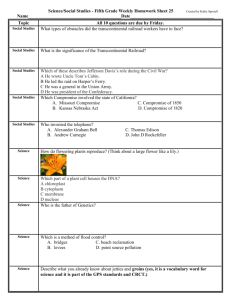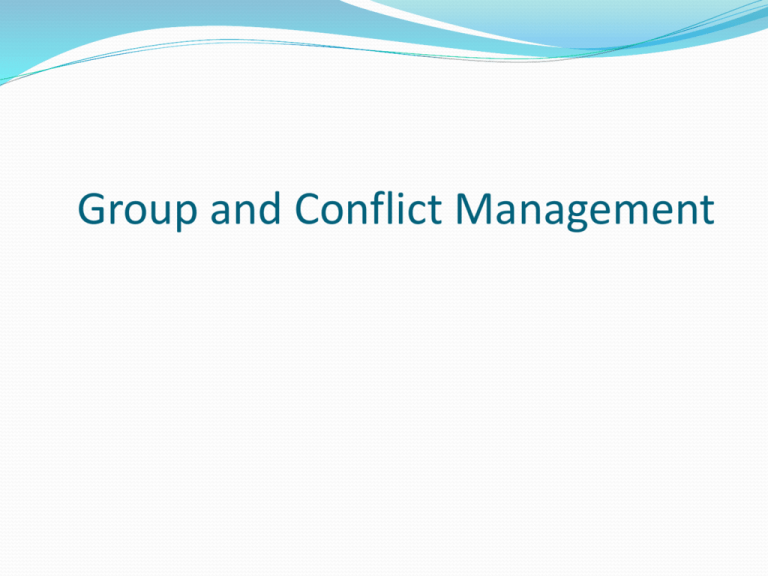
Group and Conflict Management
Group Communication and Conflict
Types of Conflict:
a) Affective Conflict - drawn from emotions
b) Substantive Conflict – associated with the task/job, not
individuals.
Group and conflict
Nevertheless, conflict is not automatically a bad
thing.
a) Constructive processing of differences can
produce high quality decisions, encourage growth
and strengthen groups/individuals.
a) Destructive conflict can result in poor quality
decisions, discourage learning and cause ongoing
harm to groups/individuals.
Constructive & Destructive Conflict
Constructive Conflict
Destructive Conflict
Affirms differences and
Uses differences as
sees their potential for
enriching outcomes.
divisions -dichotomous
(wrong/right;
bad/good;weak/strong).
Participatory - win/win;
shared power; focused on
group/common interest;
safe.
Competitive - win/lose;
powerful/ powerless;
focused on self
interest;scary.
Constructive & Destructive Conflict
Constructive Conflict
Attitude of curiosity,
genuineness,humility & respect.
(Reflected through listening,
questioning, validation,
affirmation, empathy, a power
withapproach & openness.)
A 2-way process - trying to
achieve mutually acceptable
outcomes; broad vision; open to
change; focus on the issues;
rational.
Destructive Conflict
Attitude of confrontation,
dominance &
aggression/passive-aggression.
(Reflected through dumping,
put downs, talking over, hurting,
abuse, violence, blaming and
taking power over others.)
A 1-way process - trying to win
preferred outcomes; narrow
vision; resistant to change;
personalises issues; irrational.
Constructive & Destructive Conflict
Constructive Conflict
Destructive Conflict
Based on clear guidelines/ground
rules/process.
Out of control - no
guidelines/limits.
Equal information - sharing
common information base; naming
personal agendas; seeking fair
outcomes.
Uneven/unequal information - work
from stereotypes/assumptions
rather than information;
undercurrents/hidden agendas;
disinterested in fair outcomes.
High level of personal
responsibility for process; balance
between giving and taking.
Little or no personal responsibility
for process; winner takes all!
Causes of Conflict
1.
2.
3.
4.
5.
6.
Competition for resources
Task interdependence
Jurisdictional ambiguity
Communication barriers
Physical
Cultural
Psychological
Beliefs
Personality
( Aamodt, 2010)
7
Personalities:
Types of Difficult People
Type
Need
Description
Tank
Control
Pushes, yells, intimidates
Sniper
Control
Uses sarcasm, criticizes
Know-it-all
Control
Dominates conversations
Whiner
Perfection
Constantly complains
No person
Perfection
Disagrees with everything
Nothing person
Perfection
Doesn’t do anything
Yes person
Approval
Agrees to everything
Maybe person
Approval
Won’t commit or make a decision
Grenade
Attention
Throws tantrums
Friendly sniper
Attention
Uses jokes to pick on others
Think-they-know-it-all
Attention
Exaggerates, lies, gives advice
8
Resolving conflict
Prevention /prior to conflict occurrence
When conflict first occurs
Third -party intervention
When conflict FIRST occurs
The two parties should be encouraged to use conflict
resolution skills which they had learned. These skills
include:
Expressing a desire for cooperation
Offering compliments
Avoiding negative interaction
Emphasizing mutual similarities
Highlighting common goals
When conflict FIRST occurs
Key to resolving conflict is to reduce tension and
increase trust between the two parties; which can be
accomplished by :
Stating an intention to reduce tension
Publicly announcing steps to be taken to reduce
tension.
Inviting the other side to take action in to reduce
tension.
Making sure all initiative are unambiguous.
What determines one’s responses
to conflict?
Goodwin and Griffith (2007) state that one’s
responses to conflict is determined by two
considerations:
1. How important is a particular outcome to you?
2. How important is the relationship with the
other party?
Clarifying your values is very important.
Major styles
1.
2.
3.
4.
5.
Avoiding style
Forcing style
Accommodating
Collaborating style
Compromising style
(Wilmont and Hocker, 2007 in Aamodt 2010)
Conflict Continuum
I win, you lose (competition—A)
I lose or give in (accommodate—B)
We both get something
(compromise—C)
We both “win”(collaborate—D)
A
B
C
D
16
Conflict Management Style
McGraw-Hill/Irwin
©2006 The McGraw-Hill Companies, Inc.,
All Rights Reserved
Responding to conflict
Responses to Conflict: Avoidance
People will adopt avoiding approach to conflict
when the conflict is trivial to them or has little
stake in the outcome or concern with whom
there is dispute
The issues are not important to them, hope the
issues will go away.
The “cost” of engaging in the conflict is not
worth the possible benefit to be gained
Needs to buy time such as to gather information
Responses to Conflict: Avoidance
This response is also called withdrawal or
retreating (Why?)
It is failing to engage ( Corvette, 2007)
Avoidance can be partial or total.
Common withdrawal behaviours include talking b
behind the back and forming alliance with others
( Martin and Bergmann, 1996 in Aamodt, 2010).
Withdrawal can make one feel better but …..
Responses to Conflict: Avoidance
What other variables are at play if this response
style is adopted?
Triangling is a form of avoidance and it is when the
party involved discusses the conflict with a third
party; with the hope that the 3rd party will talk to
the other person who is involved in the conflict.
What is the best course of action for a supervisor
when triangling occurs?
Responses to Conflict:
Adversarial/Forcing /Competitive
This style is a win/lose approach; does what it
takes to win, with little regard for the other party.
One of the underlying belief is that resources are
limited.
This style may range from mildly adversarial to
extremely aggressive.
Behaviour that exemplifies this approach includes
making remarks with no regard to other people's
feelings, refusing to back down, belittling the
other, using accusatory tactics and the like.
Responses to Conflict: Adversarial
Forcing/Competitive
http://www.mindtools.com/pages/article/newLDR_81.htm
Responses to Conflict: Adversarial
Forcing/Competitive
This style is self-centred.
On the extreme this style may lead to trickery and
violence.
Another behaviours which may be associated with
this approach are agreeing openly but internally
dissatisfied, and criticizing, criticizing,
defensiveness, stonewalling and contempt.
Responses to Conflict: Adversarial
Forcing/Competitive
The strategy of winning at all costs holds especially
when one party considers his/her side is correct
and the other party is incorrect.
Especially crucial when each side NEEDS the
victory to gain or retain status. Examples: union or
management conflicts.
Adversarial Forcing/Competitive:
Disadvantages and appropriateness
Damage relationships.
Create other conflicts.
Backing down difficult when involves status; more
likely to prolong conflict.
Appropriate :
in emergencies, or when there is violation of
policy/ethical or legal grounds or
When the position holder is actually correct and if
winning the conflict is more important that the possible
damage to future relationships.
Responses to Conflict:
Accommodating
This style is to give up part of you want at the
request of the other ( Corvette, 2007)
Used when a person is so earnest on settling a
conflict.
Stakes are usually high and the person is
considered cooperative ( but weak).
Responses to Conflict:
Accommodating
Low in assertiveness and high in cooperation
Appropriate to use when one party wants to show
reasonableness, develop performance, create good
will, or keep peace.
Some people use the accommodating mode when
the issue or outcome is of low importance to them.
(http://www.foundationcoalition.org/teams )
Responses to Conflict:
Accommodating
The accommodating mode can be problematic
when one uses the mode “keep a tally” or to be a
martyr.
Accommodating skills:
Forgetting your desires
Selflessness
Ability to yield
Obeying orders
(http://www.foundationcoalition.org/teams )
Collaboration : Skills involved
Active listening
Nonthreatening confrontation
Identifying concerns
Analyzing input
(http://www.foundationcoalition.org/teams
Responses to Conflict:
Compromising
The person adopting this style utilizes give-and-take
strategies to enable each side to get some of what it wants
but not everything it wants.
Most conflicts are resolved through some form of
compromise so that the solution benefits both sides.
Compromise usually involves a great deal of negotiation
and bargaining.
The negotiation process begins with each side making an
offer that asks for much more than it really wants.
Each side understands what the other is doing and the
process continues until and acceptable terms are achieved (
Aamodt, 2010)
Responses to Conflict:
Compromising
The compromising mode is moderate assertiveness
and moderate cooperation.
Some people define compromise as “giving up more
than you want,” while others see compromise as both
parties winning.
(http://www.foundationcoalition.org/teams
Compromise
The compromising mode is appropriate are when:
you are dealing with issues of moderate importance,
when you have equal power status,
when you have a strong commitment for resolution, or
used as a temporary solution when there are time
constraints.
(http://www.foundationcoalition.org/teams
Compromise : Skills involved
Negotiating
Finding a middle ground
Assessing value
Making concessions
(http://www.foundationcoalition.org/teams
Responses to Conflict:
Collaboration
In cooperation or collaboration style, we are finding a way
to get the other person/group want and what we/our group
want.
It is consistent with win-win approach.
Both parties put their efforts ( creatively) together to meet
mutual goals.
Key behaviours are listening and expressing feelings and
desires in the best manners.
Assertiveness and respecting other peoples’ views are
essential too.
35
Responses to Conflict: Collaboration
The collaborating mode is high assertiveness and high
cooperation. Collaboration has been described as
“putting an idea on top of an idea on top of an idea…in
order to achieve the best solution to a conflict.”
With such a positive outcome for collaboration, some
people will profess that the collaboration mode is
always the best conflict mode to use.
(http://www.foundationcoalition.org/teams )
Responses to Conflict: Collaboration
However, collaborating takes a great deal of time
and energy. Therefore, the collaborating mode
should be used when the conflict warrants the
time and energy
(http://www.foundationcoalition.org/teams )
Collaboration
The collaborative mode is appropriate :
when the conflict is important to the people who are
constructing an integrative solution,
when the issues are too important to compromise,
when merging perspectives,
when gaining commitment,
when improving relationships, or
when learning
(http://www.foundationcoalition.org/teams )
Choosing the appropriate style
All five styles may be used in one negotiation.
Each of the five styles can be used appropriately at
different times.
The collaborative style is usually the most effective
choice; but not all the time.
Styles may vary from person to person and from
situation to situation.

